


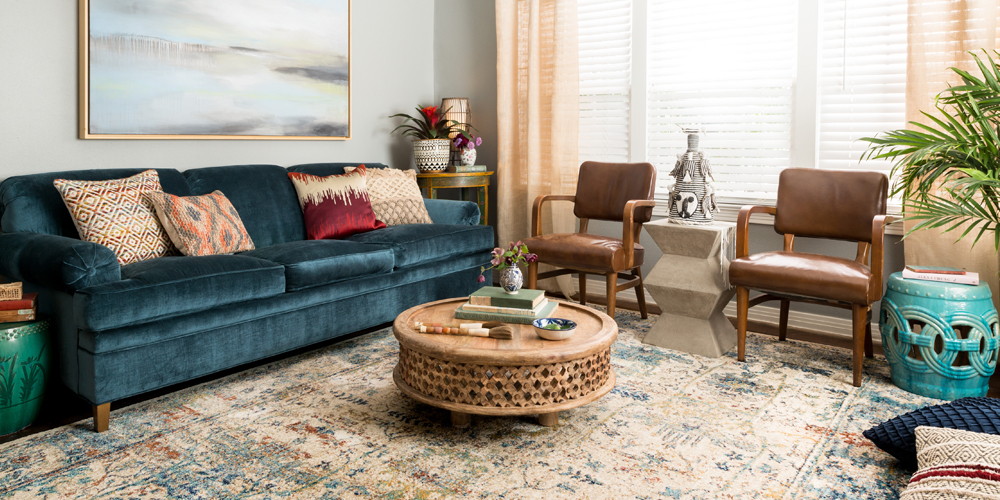
The right rug can do more than just help define a space. It can protect your floors from wear and tear while adding to a visually appealing aesthetic with its colors and patterns. However, purchasing a rug is no easy task. You must consider your lifestyle, placement of the rug, design of the rug, and what you will need from a rug. We’ve compiled the ultimate guide to help you find the exact rug that will fulfill the needs of your space.
Learn more about:
Rug Sizes & Placement | Rug Construction | Rug Materials | Rug Patterns | Rug Shapes | Rug Care | Rug Terms
The weave of a rug can determine the feel, look, and durability overtime. Although rugs can now be made more efficiently, there are still many craftsmen who tediously weave rugs by hand.
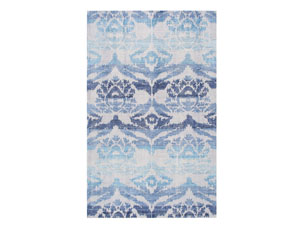
Hand-knotted rugs are very labor intensive with lasting results. They are very durable and can last for over 20 years with minimal shedding. The most common fiber used is wool. Because hand-knotted rugs are very labor intensive to create, they can take on average 5-7 months to be completed, sometimes even longer. The time and labor put into creating a hand-knotted rug does make it considerably pricier than other. Weavers will begin by hand tying knots onto warps before tying tufts of wool around the warp creating knots. The end of knots create the pile. Wefts are then threaded through in order to tighten the knots. This creates the foundation of the rug. The more knots per inch, the more intricate the pattern, and usually the more durable the knots will be. There can be imperfections or irregularities to a hand-knotted rug since it is created by hand, but this just adds to the charm of a handcrafted rug.
Good to Know: The backside of a hand-knotted rug will show individual knots and the overall design and colors of the rug’s surface.
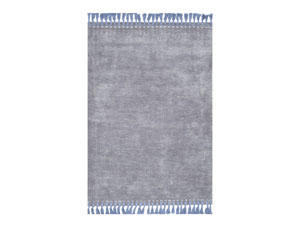
Hand-tufted rugs are durable and on average last between 3-10 years. These rugs can be made from a variety of patterns, colors, and textures. Hand-tufted rugs are similar to hand-hooked rugs, but have a flatter, cut pile surface and use more fibers, a heavier backing, and the loops are shears to the desired length. The price of a hand-tufted rug depends on the fiber that is being used and these rugs can take on average 3-5 months make. The process begins by having the design drawn onto a canvas and stretched over a frame. The craftsman will then use a hand tool to punch strands of fiber into the canvas, filling the pattern with the appropriate color. When the piles are fully formed, it is removed from the frame and a scrim fabric is glued to the back of it. The scrim backing is there to help keep the fiber pile firmly in place.
Good to Know: The backside of a hand-tufted rug will show a canvas backing that has been applied with an adhesive to hold the yarns together. When vacuuming, beater bars should either be removed or heightened.
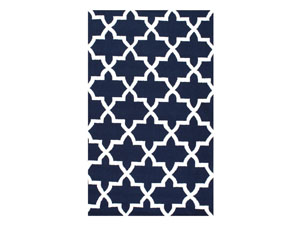
Hand-hooked rugs are durable and on average last between 3-10 years. These rugs have large loops that create a plush feeling with smaller loopers creating a detailed pattern and texture. The process of crafting a hand-hooked rug is similar to creating a hand-tufted rug. A stiff woven base is stretched over the frame with a design printed on it. Then loops of yarn is pushed through the base, leaving the yarns uncut. The basic loops used are Gross point, Petit Point, and Micro Point. The smallest loop will produce the finest weave with a more detailed design and tends to be more durable than the other loops.
Good to Know: The backside of a hand-hooked rug will show a canvas backing that has been applied with an adhesive to hold the yarns together.
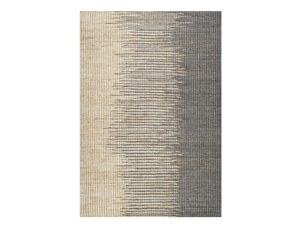
Unlike other handcrafted rugs, there is no backing material used in a flatwoven rug. These rugs are very durable and can last for over 20 years. There is a variety of patterns and color options available for flatwoven rugs, but not a variety in textures. Common fibers used are wool, jute, and cotton and flatweave rugs can take about 3-4 months to create. The process uses a loom where the weft yarn is weaved across a warp yarn. This step creates something similar to a basket weave design. There are no knots used, unlike the other handcrafted rugs, making it less labor intensive. The pile is thin and these rugs can be reversible since no backing material is used.
Good to Know: A flatweave rug is reversible, meaning the back will appear the same as the front.
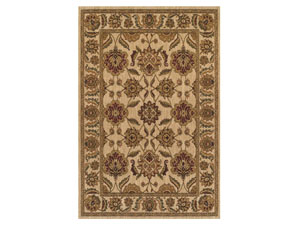
Power loomed rugs last between 3-10 years and are one of the more affordable rug options. These rugs take about 2-3 months to manufacture, usually using synthetic yarns. Because the design is programmed into the machine, the appearance of the rug is restricted to a certain set of colors once it is in production. Essentially, the computer dictates the texture, design, and color of the rug. Since production is computer driven, there is usually little to no error in the final product. The computerized loom has hundreds of spindles of fiber that are mechanically woven into a thin mesh backing continuously, maximizing efficiency.
Good to Know: The backside of a power loomed rug will show the overall design and colors of the rug’s surface with a coarse latex backing that secures everything in place.

Machine tufted rugs use a specialized multi-needle sewing machine where hundreds of needles will stitch hundred of rows of pile yarn tufts through a backing fabric. The loop will hold the yarn in place, creating a tuft, while the needle is being removed. The yarn is either caught by loops creating a loop or cut by blades creating a cut pile. The pile thickness can be anywhere from ?’’ to 2’’ high. The secondary backing is then applied before being dyed, cut, and having the edges finished.
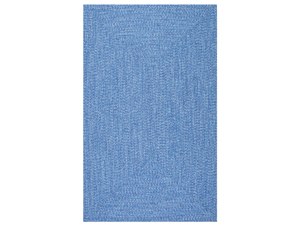
Braided rugs can be made with various constructed braids including: banded braid, cloth braid, flat braid, and yarn braid. They are usually made from 100% wool, giving braided rugs a thick and luscious look, which are also reversible. The fabric is braided then stitched together to hold these rugs together.
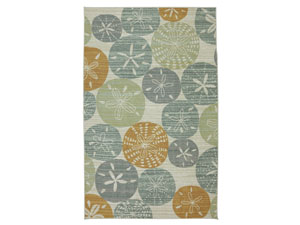
A needle felt rug is made from a dense mesh rather than a true weave. Barbed or forked needles make for a high, highly durable surface and these rugs are often used in places with high traffic, like offices and airports.
The size of a rug can easily change the dynamic of a room. The general rule of thumb is to leave at least 18-24" between the edges of the rug and the room's walls on every side, and find a rug that is sized proportionally to your furniture. Before deciding, consider marking the rug size in a room to test how a particular rug will appear in your space.
1) Define the Dimensions
Outline the area where you want a rug to be placed with a measuring tape, masking shape, or a folded bed sheet to see how a rug of a certain size could look in the room. Consider the location of doors and how they will open too, making sure it will not get caught on the rug when opened.
2) Keep at Least 18 Inches of Bare Floor Exposed
The key here is to get the proportion between your room and the rug size right.
3) Rugs Can Create an Optical Illusion
Rugs can give the illusion of a larger room. Purchasing a rug too small will make your space appear smaller. A larger sized rug will help make your room appear larger than it actually is.
4) Break the Rules
Not all rules are meant to be followed. If the layout of your room is unusual or the way you have your furniture arranged is different, be flexible. If you think it looks good, then do it!
The size of a rug for your living room depends on the size of the room and how the furniture is arranged. Rugs are perfect in living rooms because they can add warmth and add the illusion of space. A rug can also help absorb any noise, which is useful in high traffic rooms. There are usually three ways you can arrange furniture on a rug in the living room.
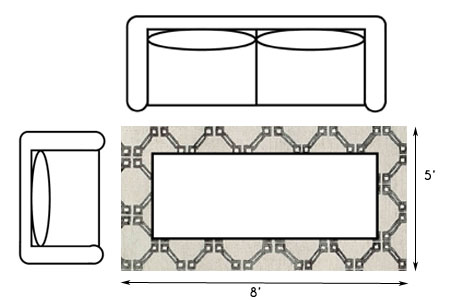
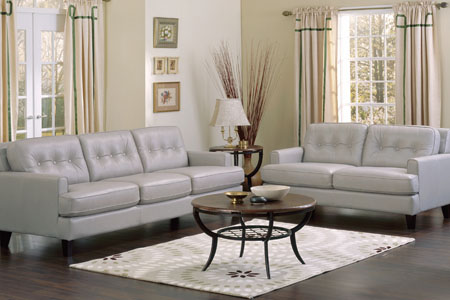
If you have a small living room or just prefer all the furniture to be off the rug, a 5’ x 8’ or 6’ x 9’ rug should do the job. Your coffee table can be placed on the rug, with the rest of your furniture surrounding it. This can easily help pull the pieces together.
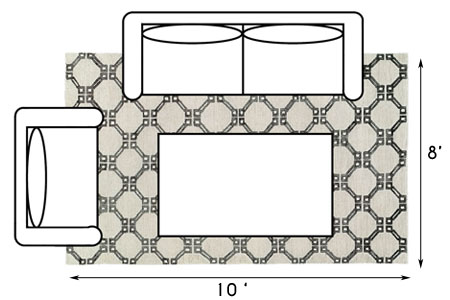
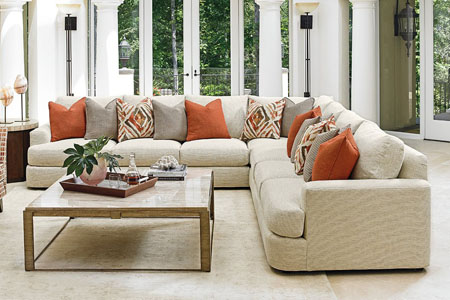
For this look, an 8’ x 10’, 7’ x 9’, or 9’ x 6’ rug will be perfect in most living rooms. With this method, the area rug should be large enough so that the front legs of your furniture pieces sit on top of the rug. This is a great way to help define the living room space.


With this approach, there should be a large enough rug that will allow for all furniture pieces to sit on the rug. Rugs that are 9’ x 12’, 9’ x 13’, or 10’ x 13’ should be able to do the job. This can help unify a room.

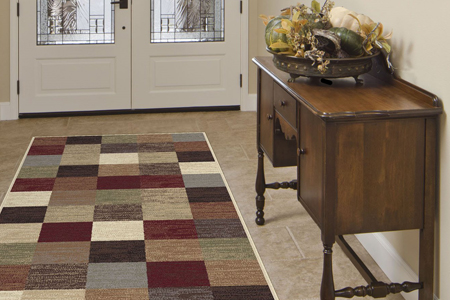
A runner should be used in hallways where the width falls a few inches short of the space. A long runner that can fill the space should be used, because it will make the room appear longer. If there is furniture on both sides of the hall, choose a width that fits in the middle. If there is only furniture on one side of the hall, consider a rug wide enough to fill the empty floor space.
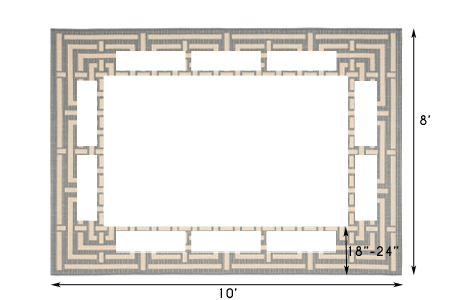
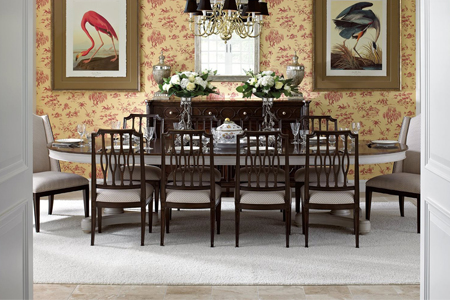
A general rule of thumb regarding rug sizes in dining rooms is a rug that will extend at least 24 inches around the dining table while leaving a minimum of 18 inches of exposed flooring on all sides. This will allow chairs to be pulled out without getting caught on the rug.
The size of your bed and floor space will usually dictate the size of the rug for your bedroom. As a rule of thumb, an area rug should extend at least 18 inches from the sides of your bed.

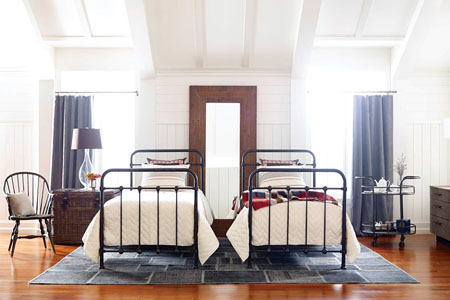
Due to the small size of a twin bed, a 9’ x 12’ rug should be able to pull the look of the room together. Remember to take in the bed’s positioning and size of room into consideration though. If there are two twin beds in the room, be sure the rug length will be long enough to be placed under both beds.
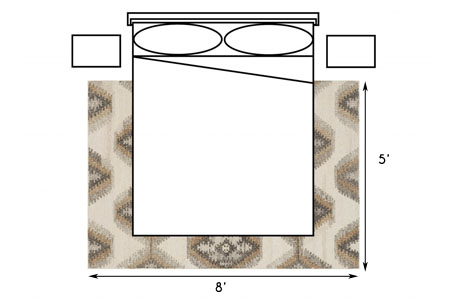

Laying a 5’ x 8’ rug horizontally underneath a full size bed is a great option. Exposing the rug at the foot of the bed will create a great look.
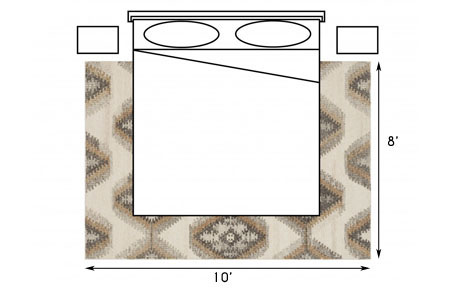
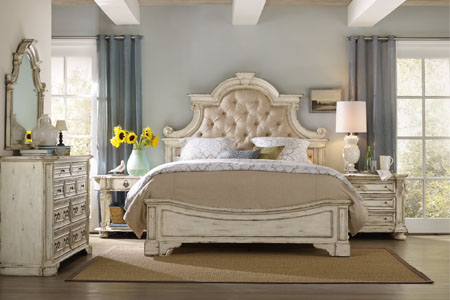
Laying an 8’ x 10’ or 9’ x 12’ rug horizontally underneath a queen size bed is a great option. The larger size can create the illusion of a larger room.
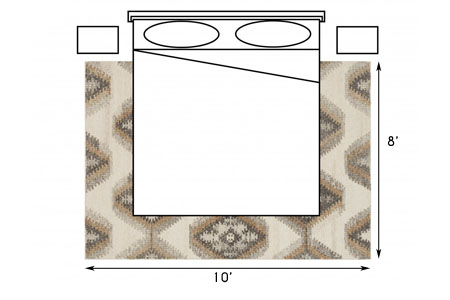
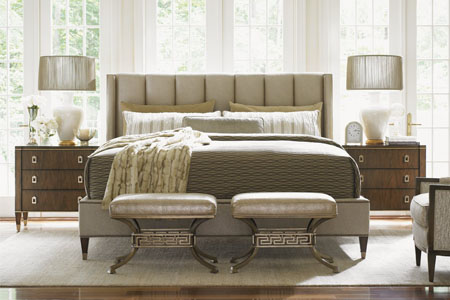
Due to the large size of a king size bed, a rug smaller than 8’ x 10’ will appear out of proportion. Aim for around 8’ x 10’ or the common rug size of 9’ x 12’.

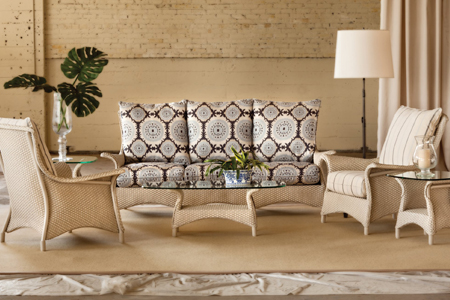
A patio rug can help define the space and create a welcoming place to entertain your friends and family. Create a look that’s pulled together by adding a durable, weather resistant rug to your patio. Consider the scale of your patio furniture arrangement, allowing 12-18 inches beyond the edges of your patio furniture. Layout rules are essentially the same as the rules applied to indoor living rooms and dining rooms. Common sizes are 2’ x 3’, 5’ x 8’, and 8’ x 10’.
The way a rug looks and performs depends on how it is constructed, and there are several ways rugs are made today. Rugs are either machine made or handmade by craftspeople. Machine made rugs are usually the more affordable option, using both natural and synthetic fibers, with plenty of styles, colors, and patterns to choose from. Handcrafted rugs, however, are usually made from natural fibers and tend to be the pricier option due to the amount of work required to craft these rugs.
All area rugs will have a backing system that will help keep the tufts in place. Most backing systems will have a primary backing, a chemical adhesive, and a secondary backing. The yarn is usually attached to the primary backing with a synthetic latex. The secondary backing is then attached to provide even more stability.
Looms hold the foundation threads (called the warp and the weft) in place so that knots can be tied around them to form a pile. The warp fibers run up and down on vertical looms. Higher quality rugs tend to have thinner warp fibers that are placed closer to each other. Weft fibers simply weave in and out of the warp fibers. They separate the rows of knots in all pile rugs.
Knots are the yarns woven around the warp and the weft. The different types of knots can be used to place the rug’s geographic origin as well as determine the appearance of the pile, or lack thereof. It is important to remember that not all rugs have piles; those that do not are called flat weaves. Knot density is the measure of knots per unit area of a rug. Knots are counted vertically and horizontally within the given area along the back of the rug. Knot density is affected by many factors: the size of warp, weft and pile threads, the presence or absence of warp depression, and how tightly the weaver packs down each row of knots. This is important because it can determine the quality of the rug. The more knots per unit the rug contains, the higher the quality.
Texture
Grading Knot Counts
Coarse
Up to 25 knots per sq. inch
Medium
40 to 90 knots per sq. inch
Fine
90 to 166 knots per sq. inch
Very Fine
Over 167 knots per sq. inch
This is one of the basic knots usually used in Persian and Oriental rugs. The symmetrical knot is done by passing the yarn between two adjacent warps, brought back under one, wrapped around both, forming a collar, then pulled through the center so that both ends emerge between the warps. The Turkish knot is sturdier than the Persian, or Senneh knot, but produces a less fine weave.
This knot can be either Persian or Turkish in style and makes the weaving process faster. The Jufti knot is tied around four warps instead of the usual two. This technique uses half the material and takes only half as much time to create. As a result, a Jufti knot rug will probably last only half as long as higher quality rugs.
A rod, which establishes the length of the pile, is put in front of the warp to create the Tibetan knot. A continuous yarn is looped around two warps and then once around the rod. When a row of loops is finished, the weaver cuts the loops, thereby freeing the rod and creating the pile.
As rows of knots are completed, the weaver must pack them down with a large metal comb. The loose ends of these knots form the pile of the rug, defined as the density of the fibers. Periodically, the weaver will sheer off some of the extra yarn that has been left on the knots. By trimming the pile, the design becomes sharper and the pile height is made shorter.
Natural dyes are made from vegetable or mineral sources. Madder root, saffron, pomegranate, walnuts, indigo, and iron oxide are all used to create natural dyes. Synthetic dyes are made from either aniline or chrome. Aniline dyes are derived from chemical processes rather than from natural resources. Chrome dyes use potassium bicarbonate and come in a wide range of rich colors.They prove to be colorfast and non-corrosive to wool.
The fiber used is one of the most important factors when purchasing a rug. The fiber used can determine the durability, softness, and style of the rug. It is up to you to decide what qualities matter the most in your space.
Natural fibers are naturally renewable, biodegradable, sustainable and green.
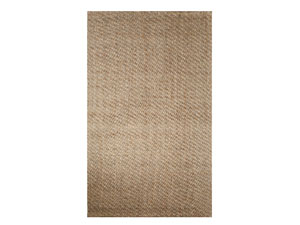
Jute is a strong natural fiber derived from the Jute plant that grows rapidly during the rainy seasons. It creates coarse and firm threads but is very malleable making it easy to make tight braids or chunky weaves without any breakage occurring. It isn’t as comfortable as other natural plant fibers. It is ideal for layering with other rugs and can give off a casual feeling. It is very durable and can last for years when cared for on a regular basis. A Jute rug will perform well in low to medium traffic areas.
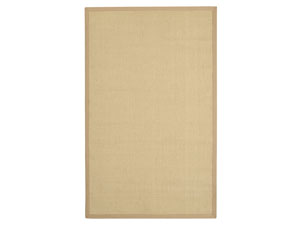
Sisal is a strong natural fiber that is sustainably harvested from the leaves of a cactus plant. It has a smoother, finer surface with a frayed, rope like texture. It is the strongest and most durable natural plant fiber and generally a neutral light beige color. It is ideal for layering with other rugs and can give off a casual feeling. It is very durable and can last for 3-10 years when cared for on a regular basis with the only caveat being that liquids can penetrate the fiber and leave a stain if not cleaned up quickly. It does well in high traffic areas.
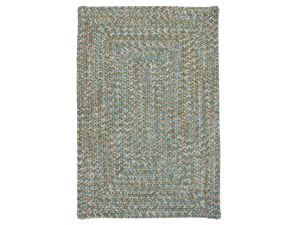
Seagrass is a strong natural fiber that grows underwater in many parts of the world. It is the least scratchy and most pliable natural rug material. Seagrass is available in many neutral tones, usually with a green undertone. It is ideal for layering with other rugs and can give off a casual feeling. It is very durable when cared for on a regular basis. Seagrass is not suitable for styling in high moisture areas.
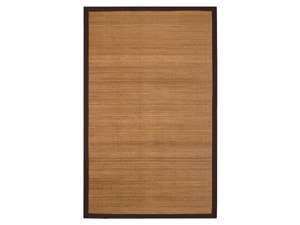
Bamboo is a very durable, pliable fiber. Bamboo can be a great option for any allergy sufferers. It is ideal for layering with other rugs and can give off a casual feeling. It can last for 3-10 years when cared for on a regular basis. It does well in high traffic areas.
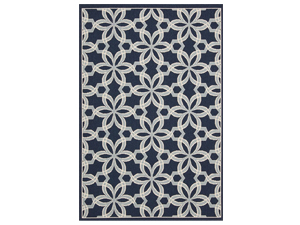
Cotton is a soft, natural fiber that is strong and stable. It is considered to be the more affordable option to wool and is usually used in flatweaves and braided rugs. Since cotton can be easily dyed, these rugs come in a wide array of colors. Most cotton rugs are machine washable, but refer to the cleaning instructions that come with your rug before putting in the washer. The cotton pile can become felted and easily attracts dirt but it is also considered to be a breathable fiber. Because this fiber is sensitive, it shouldn’t be placed in high traffic areas.
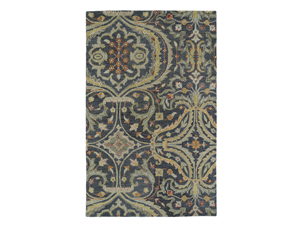
Wool is a soft and natural fiber that usually creates a thicker rug, providing a very soft cushion. Sheep are usually the source for wool, but alpacas and Angora goats are also options, the latter producing Mohair which is rare and expensive. Wool contains a natural protectant, lanolin, which helps protect against soil and stains. It is hard for spills to penetrate wool, so quickly cleaning up spills should prevent any stains. This fiber tends to shed at the beginning, so getting your wool rug professionally cleaned is suggested. Wool is a great option because of its ability to retain its shape due to its natural resistance to cushion and it can help moderate the temperature and humidity, although it should not be placed in a damp room since it tends to soak up humidity. Wool is also able to act as an air filter to provide healthy air in a home. Because it is so durable, it is ideal for high traffic areas. Wool is also fire resistant and static resistant.
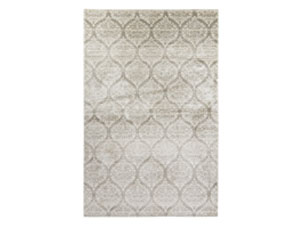
Silk comes from the cocoon of silkworms and due to the amount of handling and processing involved to obtain silk, it is rather expensive. The natural sheen and luster that comes from it however, may be well worth it. It is one of the strongest natural fibers that provides a luxurious and soft feel. To keep costs low, it is sometimes combined with other materials, such as wool. Silk is hypoallergenic, actively static, tear resistant, and resistant to mold, mildew, and fungus growth. However, it is sensitive to moisture and is less sturdy when compared to a wool pile.
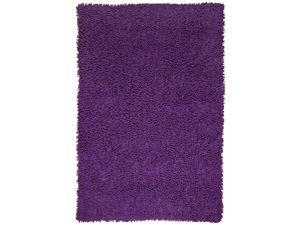
Chenille is a velvety material that is often made from cotton, wool, silk, or rayon through a twisting process that mimics silk. Long fibers are twisted at an angle around base fibers creating a deep, luxurious pile. Because of its softness, chenille is not ideal for high traffic areas. Consider placing chenille rugs in rooms with low traffic.
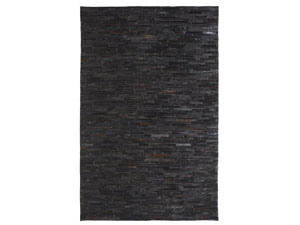
Leather tends to be soft and durable. It is stain resistant, making it very easy to clean. Although available as hides, leather can also either be stitched or weaved together creating a quilt-like design, or ribbons of leather can be put together to mimic a shag rug. Avoid placing a leather rug in a damp or humid room.

Hemp is a natural fiber derived from cannabis plants that has become increasingly popular with the green movement. It has a texture similar to linen that softens with use. It’s easy to dye and its fibers are extremely tough and durable, making it ideal for high traffic areas.
Synthetic fibers are used to mimic the look of wool and other high quality fibers but at a lower price point. Synthetics are typically very durable and easy to clean, with the bonus of being fade and stain resistant. Because synthetic fibers are available at a lower price, they can be replaced more frequently, however, synthetic lacks the natural feel of natural fibers.
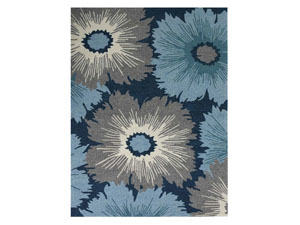
Polypropylene is a great alternative to wool, especially if you plan on placing the rug in a damp, high traffic area. It is stain-, water-, and fade resistant making it very durable, although its fibers do sometimes get crushed overtime. It is the go-to material for indoor/outdoor rugs due to it being strong, colorfast, and mildew/moth resistant.
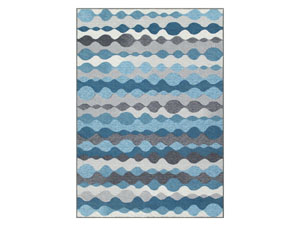
Considered to be the best synthetic fiber to be used in a rug, nylon is easily cleaned and naturally mildew/moth resistant. Nylon is also colorfast and is considered to be the most resilient and durable of all synthetic fibers.
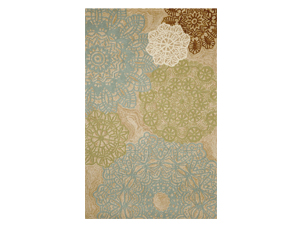
A synthetic polymer, acrylic gives off a silk, high sheen look that is not as durable as other synthetic fiber. However, it does clean easily and is mildew/moth resistant. It is also colorfast and can aesthetically mimic wool.

Polyester is a manmade fiber that is durable, inexpensive, and easy to maintain. It tends to have a soft, luxurious look with a high luster and ability to hold bright colors. It is mildew/moth resistant and tends to be a more sensitive fiber, making it ideal for low traffic areas.
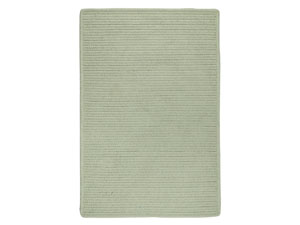
A branded material, Sunbrella is a cotton like canvas made from acrylic fibers that is colorfast and durable. It is also mildew resistant and easy to clean.
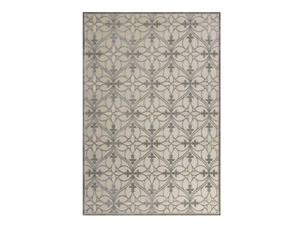
Often used to mimic silk, viscose is a type of rayon that is considered to be semi synthetic due to its natural cellulose. The silky, cool breathable fiber is a natural replacement for real silk because of its affordability and performance.
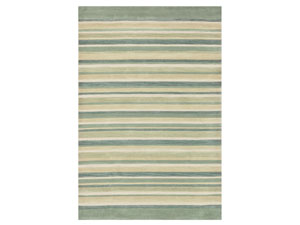
One of the most common materials used today, polyacrylic is a blend of synthetic fibers that has proven to be a great combination in indoor/outdoor rugs. Its colorfastness, durability, and cost-effective price point makes it a great option for consumers.
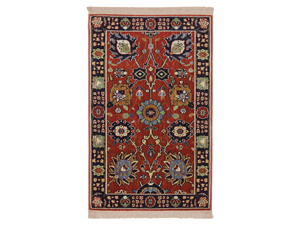
Originating from Persia, traditional rugs tend to feature medallions, flower and vine motifs. They also feature borders of rich colors like crimson, gold, and navy and are typically made of wool, cotton, or silk.
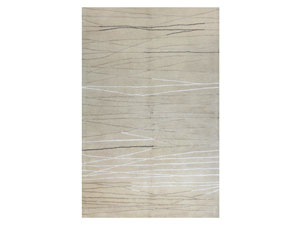
These rugs come in many styles, colors, and patterns, including solid, textural, floral, and geometric. Modern rugs can make a bold statement with patterns or provide a muted foundation and backdrop for modern art or furnishings.
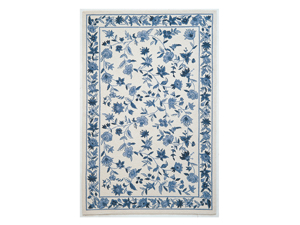
Transitional rugs refer to the actual design and style of a rug which blends the classic heritage of traditional carpets with contemporary trends that are fashionable today. Transitional rugs designate a specific yet broad style that aims to provide the elegance and timelessness of a traditional pattern with a little less formality that is typically associated with traditional styles.
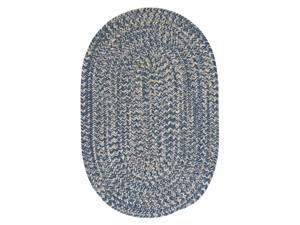
Considered one of the most classic styles of rugs, country braided rugs are a perfect addition to any casual space. They are helpful in protecting your floors from scratches and daily wear and tear and can be incorporated into almost every room of your home.
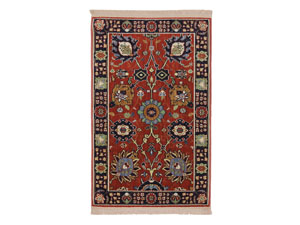
Oriental rugs are hand-knotted rugs, often featuring symmetry in their design, resulting in intriguing patterns. Oriental rugs come in many different colors, styles, and shapes and are usually made with sheep’s wool.
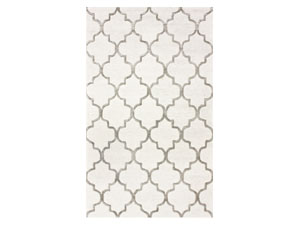
Authentic Moroccan style rugs are distinguished by their unique fabric content, knotting techniques, and traditional dyes. Along with hand-crafted styles, the term today includes any rug featuring a pattern lifted from traditional Moroccan design. Revisited and reimagined throughout centuries of production, Moroccan style rugs were widely popularized in the West by designers in the mid century, and Moroccan styles rugs have enjoyed a status of pervasive relevance in the modern era.
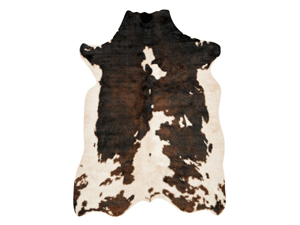
An animal rug pattern which mimics an actual animal skin is quite clever and popular. The edges are uneven and the aesthetic is life-sized so that you can experience a more authentic look and feel. Faux animal print rugs offer the same lavish texture as real hide, however they are animal-friendly and better for the environment.
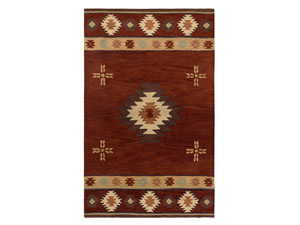
Southwestern rugs bring a dose of the western aesthetic to any interior in an instant. From traditional Aztec-inspired designs to modern western-style rugs, these styles bring together rugged sophistication and pioneering flair for a singular look. Southwestern rugs add an element of soft comfort and dimension to a room, and can help reduce noise echos.
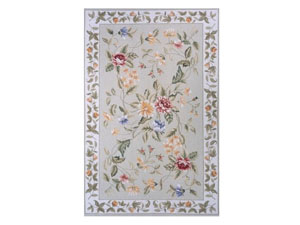
Floral rugs are one of the most beautiful and captivating prints, exuding the warmth of summer and the loveliness of springtime. From the living room to the bedroom, modern floral rugs can work effortlessly to brighten any space in your home.
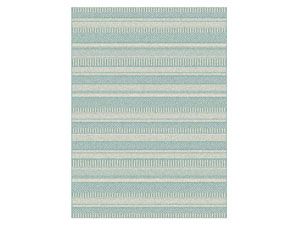
Striped rugs are one of the most popular rug patterns available. The inclusive and general descriptor includes any rug with a recognizable pattern of alternating strips of material.

Geometric patterns have become a popular choice in area rug design. Chevron rugs feature a distinctive zig zag rug pattern. Traditionally imagined with evenly placed black and white zig zag stripes, straight lines, and sharp angles, the chevron pattern has evolved to include a wide range of styles and colors. Chevron stripes can be rounded, textured, or mixed with other patterns to achieve a variety of aesthetic look.
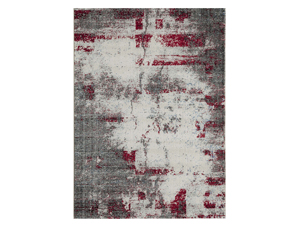
Abstract rug designs range from cascading printed curves and bursts of color to soothing geometric patterns. Both contemporary area rugs and traditional styles can carry abstract designs, and a rug’s pattern or coloring generally determines the rug’s dominant style.
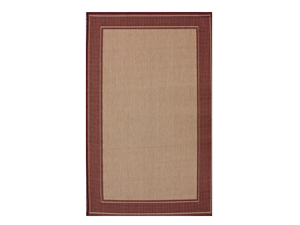
Border rugs include all area rugs with borders. Area rugs with borders includes a wide range of colors, styles, and materials. The borders of these types of rugs can also vary in width, style, and functional purpose.
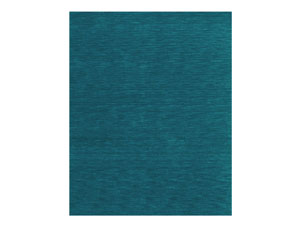
Solid area rugs are one of the best ways to give your bare floor an updated look that is exciting and fresh like the new day ahead. There is a variety of shapes, colors, textures, and sizes from which to choose in solid color rugs.

Runners are long, rectangular rugs that are usually placed in the hallway. They can protect your flooring from wear and tire while making a huge design impact on the narrow space.
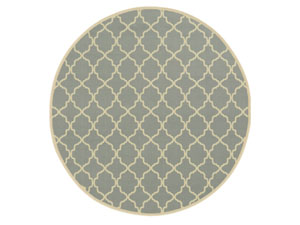
Round area rugs are a unique choice and can add personality to your home regardless of what room you place them in. Round kitchen rugs can fit perfectly under a dining table set while large round rugs are perfect for living rooms and bedrooms.
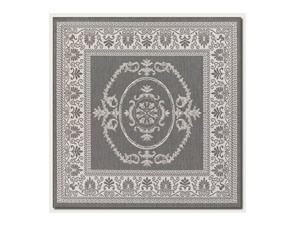
Square shaped rugs are one of the most versatile and practical shapes. There are many different styles and designs of square shaped rugs to choose from.
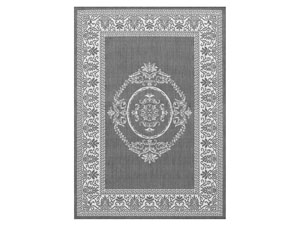
Rectangular rugs create the essential ambiance necessary for every warm and welcoming living space; their advantageous shapes allows for plenty of room to style, decorate, and arrange furniture or other decor that contributes to the overall aesthetic of the environment. It is proven to be the most popular type of rug and succeeds in accomplishing the task of adding beauty and character to the floor while offering a comfortable tough to the feet and feel of the room.

Octagon rugs are a great way to add character to any room in your home. It’s a fun and unique shape that will help to make your furnishings stand out in your room. The hybrid shape of an octagon rug features eight sides mixing the circular shape of a round rug with the cornered edges of a rectangular or square rug. The effect is a distinctive graphic shape that adds extra dimension to the design of your home.
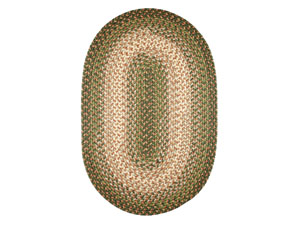
Oval shaped rugs in particular are a very unique piece to add to any floor, that bring a sense of character and charm to your space. Oval kitchen rugs can fit perfectly under a dining room set while oval rugs 8x10 size make great additions to any living room.
It’s possible to keep your rug looking as beautiful as day one, but it’s going to require a little cleaning and maintenance on your part. Follow these tips and trick to keep your rug looking good as new.
Vacuum regularly, at least once a week with a regular pile.
Consider removing the beater bar of the vacuum before vacuuming a loop/braided/tufted rug. Another option is to set the vacuum at its highest setting.
Shake out a shag rug first to loosen all dirt and particles from it. Use a handheld attachment to vacuum shag rugs.
There are different ways to clean a rug, depending on the fiber it is made up of. Always follow the care instructions that come with a rug. The following tips may not apply to all rugs.
Small cotton rugs are usually machine washable. In these cases, wash the rug in warm water with a mild detergent. Larger cotton rugs should be treated with a dry cleaning powder.
New wool rugs will usually shed. Vacuum at least once a week. Use a common wool detergent with a teaspoon of neutral detergent and a teaspoon of white vinegar mixed in a quart of warm water to clean any liquid stains.
Blot any stains with a dry cloth, then use a mixture of water and vinegar to treat the stain.
Dab with small amounts of club soda or use a damp, soapy cloth to treat any stains.
Vacuum at least once a week. Use a common wool detergent with a teaspoon of neutral detergent and a teaspoon of white vinegar mixed in a quart of warm water to clean any liquid stains.
Vacuum at least once a week. Use a common wool detergent with a teaspoon of neutral detergent and a teaspoon of white vinegar mixed in a quart of warm water to clean any liquid stains.
Rugs made of viscose should be professionally cleaned. Between cleanings use a spot cleaner that emits very little moisture. Viscose does not react well to moisture, so extra care must be taken in the cleaning of these rugs.
Use a solution of detergent and vinegar mixed in water or a common cleaning detergent to treat any stains.
|
Stain |
Cleaning Method |
|
Acids |
Detergent or white vinegar |
|
Alcoholic beverages |
Detergent, white vinegar, or cleaning fluid |
|
Ball-point pen ink |
Methylated spirits or turpentine |
|
Beer |
Detergent or white vinegar |
|
Blood |
Detergent, white vinegar, or starch paste |
|
Candy |
Detergent, white vinegar, or scrape & vacuum |
|
Chewing gum |
Detergent, white vinegar, or cleaning fluid |
|
Chocolate |
Detergent, white vinegar, or cleaning fluid |
|
Coffee |
glycerin |
|
Crayon |
Detergent, white vinegar, or cleaning fluid, or scrape & vacuum |
|
Fat and oil |
Tissue and iron, then cleaning fluid (do not use iron after solvent) |
|
Fruit and juices |
Detergent or white vinegar |
|
Furniture polish |
Detergent, white vinegar, or cleaning fluid |
|
Glue |
Alcohol |
|
Grass |
Methylated spirits |
|
Grease |
Cleaning fluid or scrape & vacuum |
|
Ice cream |
Detergent, white vinegar, or cleaning fluid |
|
Ink |
Water only |
|
Mildew |
Call a reputable cleaner |
|
Mud |
Detergent or white vinegar |
|
Oils |
Cleaning fluid |
|
Paint |
Detergent, white vinegar, or cleaning fluid |
|
Perfume |
Detergent, white vinegar, or cleaning fluid |
|
Sauces |
Detergent, white vinegar, or cleaning fluid |
|
Tea |
Detergent or white vinegar |
|
Urine (human) |
Detergent or white vinegar (remove at once - chemicals in urine attack dyestuffs) |
|
Urine (pet) |
Call a reputable cleaner |
|
Vomit |
Detergent, white vinegar, or cleaning fluid |
|
Wine |
Detergent, white vinegar, or cleaning fluid |
Rug pads prevent rugs from sliding, buckling, and wrinkling. This also helps prevent slipping and accidental falls. Non slip pads for rugs also come in a rubber backed design with a needle punched fabric. These will help extend the life of your rug.
Sewing
Use a rounded upholstery needle to sew the braids of a braided rug back together. Mend other types of rugs by taking the torn ends and sewing from the underside with a thread that matches the rug.
Duct Tape
If rug fibers were lost, place a piece of duct tape on the back of the rug.
Sewing
Sew over the edge using an upholstery needle with a thread that matches the color of the rug.
Pumice Stone
Vacuum your rug before gently running a pumice stone across the surface of the rug. Vacuum up the loose pills.
Carpet Fuzz Remover
Use a fuzz remover to pick up any fuzz from the carpet and discard the fibers from the fuzz remover.
Scissors
Carefully trim the pill with scissors, being sure not to snag or pull any more fibers from the rug.
Glue
A loop will unwind when loose. Retwist, then apply a small dab of hot glue to the back and press to the loop to secure.
Always clean your rug before moving it to storage. Wrap your rug, preferably with kraft paper, Tyvek, or water resistant paper. Be sure to roll the rug with the backing on the outside. Store in a climate controlled area.
A change in the color of a rug due to the differences in the wool or dye batch. The color change runs across the rug and is most likely to occur at the top. This can be caused by unevenly applying dye or using wool from different dye lots.
Continuous design throughout the field of the rug
A modern chemical washing procedure that produces softer tones or “antiques” the rug to simulate aging
A knot that may be open to the right or the left (Also known as Persian or Senneh knot)
A flat weave, pileless rug predominantly made in China and India, featuring a floral medallion with curvilinear floral borders and soft pastel colors
A design around the edge of a rug, surrounding the field. The border usually includes a wide bank with a repeating design, called the main border.
An ornamental figure often used in Oriental rug designs that sometimes represent a leaf, bush, or pinecone
The combing of fibers with wire bristle brushes prior to spinning
A heavy, often tufted fabric used as floor covering
A grid on paper with colored spaces to guide rug weavers in the execution of a rug’s design
The process of shearing around a design or symbol to enhance the look of the rug. This is common done in some Chinese and Tibetan rugs.
Rugs may be washed in chemical solutions to soften (bleach) colors, increase the luster of the fibers, and to lend the pile a softer feel
A dye that will not fade
The process of preparing wool fibers for spinning by sorting them in the same direction
The most common fiber for making weft and warp and is occasionally found in the pile
The loss of pile thickness as a result of foot traffic
A flat weave, pileless rug that is composed of simple, geometric designs. Most Dhurries are woven in India, Afghanistan, or Pakistan and are made of wool or cotton.
A substance used to color fiber, yarn, or textiles
The part of a rug’s design surrounded by the border. The field may be blank or contain medallions or an all-over pattern
Any rug woven without a knotted pile
The combination of warps and wefts in the body of a rug
Warps extending from the ends of a rug, which are treated in several ways to prevent the wefts and knots from unraveling
Narrow, decorative designs surrounding the main border
A medallion, either octagonal or angular in shape, used in Turkman designs. It is often repeated to form an all-over pattern in the field.
Any rug constructed by hand
A form of hooking; yarns are pushed through the foundation of a rug (usually canvas) with a tufting gun to form a pattern.
A knot tied over four warps instead of the usual two
A flat weave, pileless rug woven using the tapestry technique. Commonly decorated with geometric patterns and bright colors, these rugs are usually used in high traffic areas
Any fine wool
The wrapping around the warps of the yarn (usually wool) threads, the ends of which project to form the pile of the rug
Number of knots per square inch rates the knot quality in hand knotted rugs. Usually noted by the K.P.S.I designation (i.e. K.P.S.I. 240)
A wooden structure that holds the warp and weft threads for weaving the rug. It can be vertical or horizontal. The height and width of the loom determines the rug size.
The result of the untwisting of the yarn and intermingling of the yearn tips because of foot traffic.
The large enclosed portion of a design, usually in the center. Typical shapes are diamonds, octagons, ovals, and hexagons.
Top or body of the rug where the knot ends are cut.
A flat weave, pileless rug woven using a stitch similar to a cross-stitch. Mainly produced in China, workers peer through the canvas to follow the design, which is spread out underneath. Workers stitch directly onto the canvas.
One loop of a pile knot around a warp as seen from the back of the rug.
A hand knotted pile or flat woven fabric made from natural fibers (most commonly wool or silk)
A process by which selvedges are wrapped or interwoven with a yarn that is not part of the foundation weft
The mellowing of the surface appearance of a rug usually with age or use. Can also be achieved with chemical washes.
Foundation of the rug desig
The nap of the rug, or the tufts remaining after the knotted yarns are clipped
A piece of a rug sewn or woven into the hole of another rug
Two or more yarns spun together
Machine made rug
Usually rugs measuring no more than 3 to 4 ft. wide and ranging from 8 to 20 ft. in length
Any small rug under 3’ x 5’. Usually used as kitchen, bathroom, or front door rugs.
The washing of wool to remove unwanted lanolin and other impurities.
The edge warps of a rug and the foundation weft around those warps
A method of finishing edges of area rugs by using heavy, colored yarn sewn around the edges in a close, overcast stitch
The professional removal of a sheep’s wool
A flat weave, pileless rug woven from a technique that produces a herringbone effect. This special weaving technique is also known as weft wrapping. Soumaks generally have a mixed cotton and wool foundation with geometric and brightly colored designs. This weaving method is also used to produce storage bags, cradles, and other everyday necessities.
The direction of a yarn’s twist
The average length of fibers in a yarn
A written description of the numbers of pile knots and their colors needed to create a specific design. It is used in the execution of a rug’s design.
Tibetan rugs are woven by wrapping a continuous length of yarn over a rod laid across the warps stretched on the loom. When the rod has been wrapped for its entire length, a knife is slid along the rod, cutting the wrapped yarn into two rows of pile knots.
Reversals in direction of the new wefts.
Comprising the foundation, parallel warp yarns run the length of the rug and are interlaced with wefts.
A rug in which warps are more closely spaced than wefts and the wefts are concealed. In a balanced plain weave rug, warps and warps are equally visible.
A technique whereby some warps are held tightly in place while others in the same rug are held in place loosely.
The yarns woven horizontally through the warps
A rug in which the weft yarns are more closely spaced than the warp yarns
A weft wrapping method in which two wefts pass across warps, twisting together after each warp or at regular intervals
A stitch used to overcast and lock the final weft in rug ends
A wool yarn of mixed staple that has been carded. Fibers are neither as long nor as parallel as worsted yarn. The average length of woolen yarn is shorter than 3 inches.
A process that occurs prior to spinning, where wool yarns are firmly twisted from combed fibers that are longer than three inches in length. This process improves the wool’s quality by leaving only the longer pieces of fiber for final spinning. It is used to weave more intricate patterns.
A continuous, often plied strand composed of either natural or manmade fibers or filaments that is used in weaving and knitting to form cloth.



